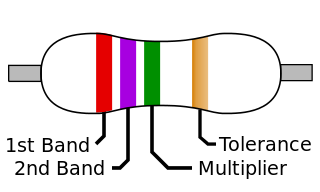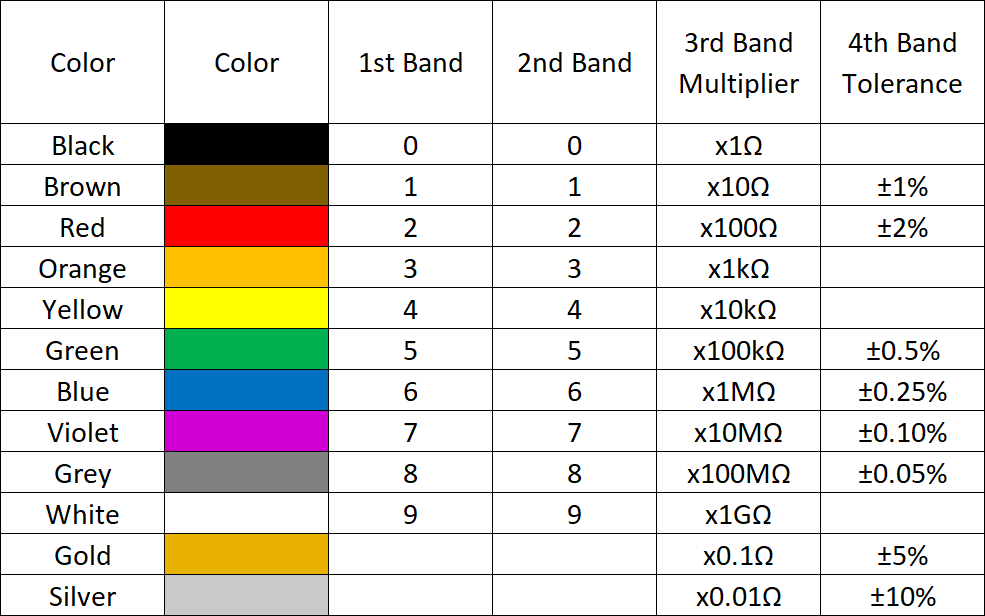The essential guide to resistors
Ever wondered how your phone manages to stay charged without blowing up or how your TV remote controls those watching marathons? It's all thanks to a tiny but mighty electronic component - the resistor. Resistors are one of the most valuable parts of the tech world. These little wizards quietly control the flow of electric current in ways that make our gadgets tick. In this article, we're taking a deep dive into the world of resistors, from the magic of Ohm's law to cracking the colorful code that reveals their hidden values.
Components
| Resistors kit
|
Calculating resistance value
At the heart of understanding resistors lies Ohm's law, a fundamental principle in electronics that relates current (I), voltage (V), and resistance (R). According to Ohm's law, the current flowing through a resistor is directly proportional to the voltage across it and inversely proportional to its resistance. This relationship is expressed mathematically as:
V = I * R
Where:
V is the voltage across the resistor in volts (V).
I is the current flowing through the resistor in amperes (A).
R is the resistance of the resistor in ohms (Ω).
This formula forms the cornerstone of understanding how resistors interact within circuits. It enables engineers and designers to calculate the resistance needed to achieve specific current and voltage values within a circuit. By manipulating the values of current, voltage, and resistance, engineers can tailor circuits to perform a multitude of tasks, from signal amplification to current limitation.
Decoding color codes
Let's talk about deciphering the rainbow of colors on resistors, which provide a visual guide to their resistance values. This ingenious system offers a quick and accurate way to identify the resistance rating of a resistor without requiring complex calculations. The color bands are typically located near one end of the resistor and can be read from left to right. Each color corresponds to a numeric value, and the order of colors determines the magnitude of the resistance.

The color code follows a standardized pattern:
The first and second bands represent the first two digits of the resistance value.
The third band indicates the multiplier to determine the order of magnitude.
The fourth band, if present, signifies the tolerance level.

For instance, a resistor with color bands of yellow, violet, red, and gold would translate to a resistance value of 47 * 100 ohms, which equals 4.7 kilohms (kΩ). The gold band in this example indicates a tolerance level of ±5%, implying that the actual resistance could vary within this range.
Common resistor values
To make it easier for engineers and designers to select the right resistor for their circuits, a set of standardized resistor values has been established. These standardized resistor values are part of what's known as the E series. The most commonly used E series include:
E12 Series (10% Tolerance): This series contains 12 values per decade. Examples include 1 ohm, 1.2 ohms, 1.5 ohms, 1.8 ohms, 2.2 ohms, 2.7 ohms, 3.3 ohms, 3.9 ohms, 4.7 ohms, 5.6 ohms, 6.8 ohms, and 8.2 ohms.
E24 Series (5% Tolerance): This series contains 24 values per decade, providing more precision than E12. It includes values like 1 ohm, 1.1 ohms, 1.2 ohms, 1.3 ohms, 1.5 ohms, 1.6 ohms, 1.8 ohms, 2.0 ohms, 2.2 ohms, 2.4 ohms, 2.7 ohms, 3.0 ohms, 3.3 ohms, 3.6 ohms, 3.9 ohms, 4.3 ohms, 4.7 ohms, 5.1 ohms, 5.6 ohms, 6.2 ohms, 6.8 ohms, 7.5 ohms, 8.2 ohms, and 9.1 ohms.
E48 Series (2% Tolerance): Even more precise than E24, this series contains 48 values per decade. This series includes values like 1 ohm, 1.05 ohms, 1.1 ohms, 1.15 ohms, 1.21 ohms, 1.27 ohms, 1.33 ohms, 1.4 ohms, 1.47 ohms, 1.54 ohms, 1.62 ohms, 1.69 ohms, 1.78 ohms, 1.87 ohms, 1.96 ohms, 2.05 ohms, 2.15 ohms, 2.26 ohms, 2.37 ohms, 2.49 ohms, 2.61 ohms, 2.74 ohms, 2.87 ohms, and 3 ohms, among others.
E96 Series (1% Tolerance): The E96 series offers even finer granularity with 96 values per decade. Within the E96 series, you can find values such as 1 ohm, 1.01 ohms, 1.02 ohms, 1.03 ohms, 1.05 ohms, 1.07 ohms, 1.1 ohms, 1.13 ohms, 1.15 ohms, 1.18 ohms, 1.21 ohms, 1.24 ohms, 1.27 ohms, 1.3 ohms, 1.33 ohms, 1.37 ohms, 1.4 ohms, 1.43 ohms, 1.47 ohms, 1.5 ohms, 1.54 ohms, 1.58 ohms, 1.62 ohms, and 1.65 ohms, among others.
These standardized resistor values are calculated using a logarithmic formula to ensure that they are spaced evenly on a logarithmic scale. This logarithmic spacing is essential because in many electronic circuits, you need a wide range of resistance values to control current and voltage. These standardized values cover a vast range of applications and make it convenient for engineers to find a resistor that closely matches the resistance needed for their specific circuit.
Conclusion
Resistors are the silent workhorses that enable the seamless operation of electronic devices we rely on daily. The Ohm's law formula empowers engineers to precisely design circuits, while the color band scheme provides a user-friendly means of quickly assessing resistor values. As electronics continue to evolve, the timeless principles of resistors remain constant, supporting innovation and progress in the realm of technology.





0 Comments